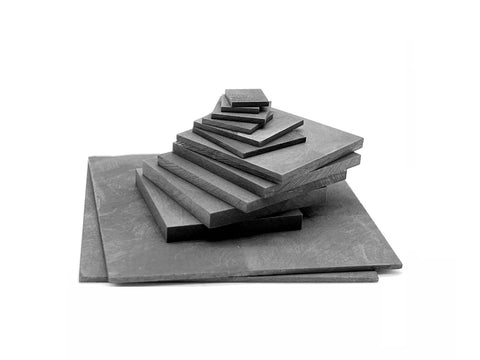
Graphite Plate - Synthetic, Vibration Molded, Pack Of 10 PCS
SKU: E-Gr-7x7x1-10p
Graphite Plate - Synthetic, Vibration Molded, Pack Of 10 PCS
Buy Redox.me products from MSE Supplies at the best value.
Graphite, a naturally occurring form of carbon, is renowned for its excellent electrical conductivity and robustness. Characterized by its layered structure with carbon atoms arranged in a hexagonal lattice, graphite is a versatile material widely used in various applications, including electrochemistry.
When used as an electrode in electrochemical studies, graphite provides a unique combination of properties, such as cost-effectiveness, ease of surface renewal, and a higher effective surface area due to its porous structure. Graphite is commonly used in electrochemical measurements as a cost-effective, readily available counter electrode.
While both graphite and glassy carbon are invaluable electrode materials in electrochemistry, there are situations where graphite particularly shines. Graphite is inherently more cost-effective, making it a favorable choice for preliminary studies, bulk experiments, or applications where budgets are tight. Its porous structure often translates to a larger effective surface area, which can be advantageous in assays requiring increased sensitivity. Furthermore, graphite's ease of surface renewal ensures consistent measurements across experiments, as it can be easily polished between uses.
Examples of use:
1. Electroplating: Due to its cost-effectiveness and porous nature, graphite is an efficient substrate for metal deposition in electroplating processes.
2. Bulk Electrolysis: For processes that require a significant quantity of electrode material, like bulk electrolysis, the affordability of graphite makes it a preferred choice.
3. Educational Settings: Graphite's durability and cost-efficiency shine in academic laboratories, especially for student experiments where cost and robustness are crucial.
Application note
1. Preparation: Ensure the graphite electrode surface is clean and contaminant-free. Due to its relatively soft nature, the electrode surface can be easily mechanically polished between uses to renew its surface.
2. Installation: Fit the graphite plate electrode into your electrochemical cell setup. Ensure a secure connection to your potentiostat to record accurate measurements.
3. Measurement: Graphite electrodes can be employed in a wide array of electrochemical techniques. Given its porous nature, ensure the electrode reaches a stable background current before recording measurements.
4. Maintenance: After usage, rinse the electrode with appropriate solvents and store it in a dry place. Regular polishing with alumina or abrasive paper might be needed, depending on the nature of the experiments.
Specification
Material: synthetic polycrystalline graphite
Manufacturing process: vibration molding
Dimensions: 5×5, 7×7, 10×10, 15×15, or 50×50 mm2 (custom sizes available upon Request)
Thicknesses: 1, 2, or 3 mm
Density: 1.75 g/cm3
Electric resistivity: 8 µΩ·m
Flexural strength: 17.5 MPa
Compressive strength: 38 MPa
Medium grain size: 800 μm
Thermal conductivity: 140 W.mK-1
Coefficient of thermal expansion: 2.4×10-6 K-1
Ash content: 500 PPM
Product Includes
10 x graphite plate
